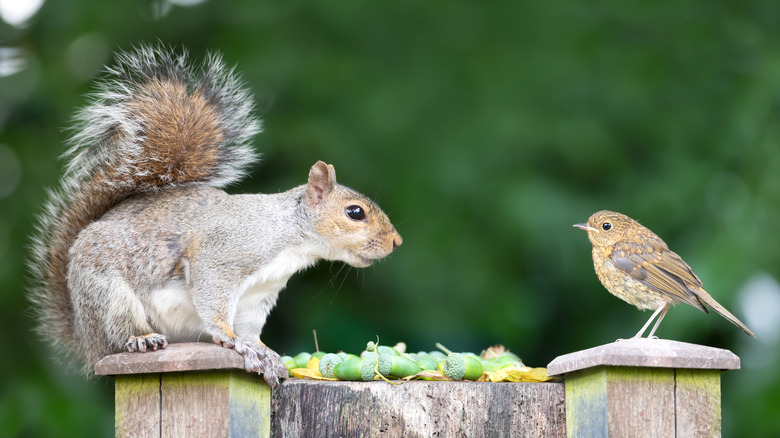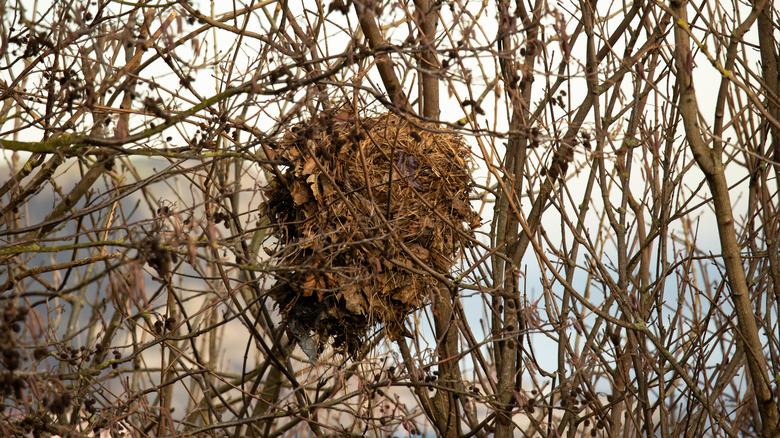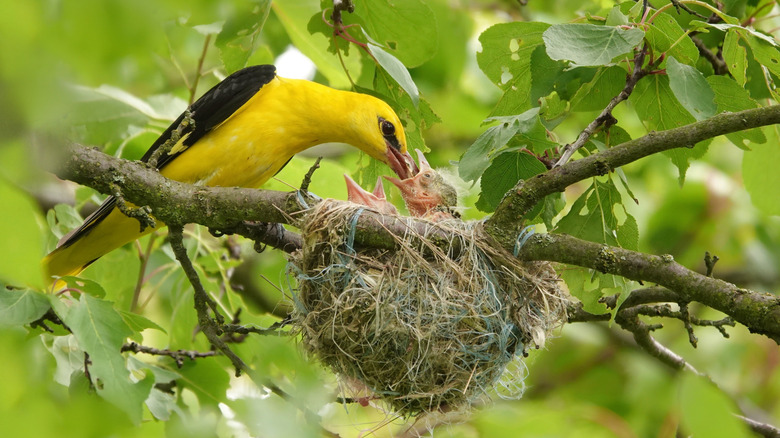How To Spot The Difference Between A Squirrel's Nest And A Bird's Nest
Spying a bird nest can feel a bit magical: the anticipation of tiny beaks poking through delicate eggshells and glimpses of mom and dad birds bringing food to their young. It may surprise you, then, to spot a squirrel nestling into what you thought was a bird's nest. Squirrels often live in tree cavities, which offer protection from predators and the elements, but they also build nests called dreys in those trees.
Depending on your preference for who camps out in your yard, you may want to understand how to differentiate a bird nest from a squirrel nest. The two types of living spaces are similar enough at a glance, but you'll see distinct traits if you look closely. One of the main differences is the location of the nest. Squirrels prefer the penthouse suite, building their homes high up in the treetops, but not for the view. For them, it's all about survival and safety, enabling them to keep watch of their surroundings — and any incoming predators.
Meanwhile, birds are less particular about location. Depending on the species, birds will set up their homes in trees (typically at lower height than where squirrels prefer), in bushes, or manmade structures like among the eaves of a house or utility pole. Knowing what these nests may look like can help you tell the difference.
The differences in nest materials and sizes
Home is what you make of it, and by paying attention to what the nest is created with, you'll likely be able to figure out if it belongs to a squirrel or a bird. One of the most distinct differences is that squirrels are more likely than birds to use leaves in their nests. They'll use twigs to first form the skeleton of the drey, and then work inward to create an enclosed spherical nest that is reinforced with softer materials like leaves, moss, shredded bark, vines, and pine needles for warmth. Birds, on the other hand, have more diversity in their nest structures and materials, using twigs but also mud. They also incorporate materials like yarn, string, even pieces of trash. So if you air-dry your laundry in the backyard, you may find a strand of your socks in the nest of your resident bird family.
A drey typically has a looser, messier appearance and can be approximately 1 to 2 feet in diameter, which is significantly larger than a typical bird nest. In comparison, an American robin's nest is 6 to 8 inches wide, and the nest of a red-winged blackbird — usually set near the ground — is slightly less than 5 inches wide. Another obvious difference is that squirrels will build a small entrance that is low in the drey and facing the tree trunk for protection from rain, versus birds constructing their nest with an overhead entrance.
Squirrel and bird behaviors with their nests
Taking time to observe the animal's behaviors also will provide more insight as to which species owns the nest. Squirrels can be spotted in their dreys year-round, although in colder climates they may move their family into a tree cavity for more warmth and protection. Birds, on the other hand, are more seasonal inhabitants, using the nests for laying eggs in the spring through the fledgling stage. Once you spot a nest in your yard, look out for increased animal activity. Squirrels will come and go either with nesting materials or with food for their kits. Birds will do the same, in addition to becoming increasingly vocal and territorial.
Squirrels, while cute, are not necessarily ideal to have in your yard. They can chew on and damage wires, ruin your garden, nibble on your crops, and even transmit diseases to humans. One way to deter them is to plant the kind of flowers that squirrels hate. You could also try natural ways to repel them from the garden by using spices. Protect your garden with mesh wire or wrap metal sheeting around trees or bushes to keep squirrels from nibbling on the bark. If you've made your yard as unappealing as possible and the squirrels are still determined to stay, consider hiring a professional to remove them. However, if a squirrel is caring for kits, hold off on pursuing removal until they are old enough to survive without their mom.


